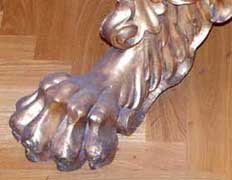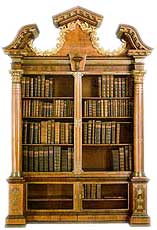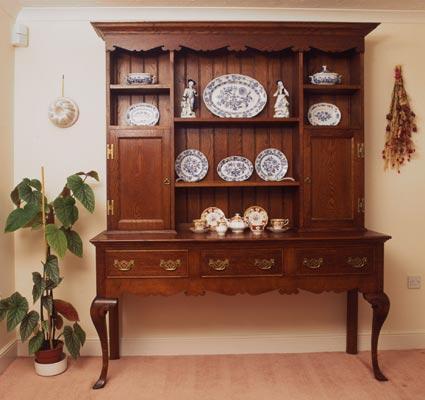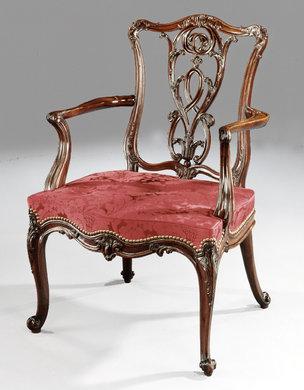Georgian Furniture – Comfort and Elaborate Design
Media Gallery
History
The Georgian era began in 1714 with the ascension of George I (Queen Anne’s second cousin). According to some sources, the period ended in 1830 with George IV; however, other authorities include the seven-year reign of William IV (George IV’s brother) as part of the Georgian period. From a historical perspective, the Georgian period was a time of tremendous social change. Abolition of slavery and prison reform were addressed and leaders focused on projects for the greater good- hospitals and orphanages. The British Empire continued to expand during this era, as well.
Wood
Georgian furniture was similar in many ways to Queen Anne furniture. Both styles made use of rich, dark woods, although by the Georgian era mahogany was far more popular with furniture makers than was walnut. Mahogany was more resistant to warping and splitting than walnut and produced sharper carvings. This led to a revival in elaborate decoration, although the cabriole legs and curvilinear lines of the Queen Anne style remained popular in Georgian style furniture.
Characteristics
Georgian pieces were heavier and, in a sense, much more masculine than Queen Anne equivalents. The shell motif was still used in many designs, but was supplemented with honeysuckle motifs, acanthus leafs, animal heads (particularly eagles and lions), masks, oriental designs, and scrolls. Hardware was typically brass.
Chairs by this time were virtually always upholstered. Red and gold were the most common colors.
The cabriole leg remained popular; the Georgian version was typically decorated with elaborate carvings.
Simple pad feet were replaced with whorl feet and paw, claw, or ball and claw feet. Corner chairs with two splats (back rests) at right angles to one another became common. Many even had candleholders to facilitate reading and writing.
Embellishments
A new technique, called gesso work, made it easier for craftsmen to create the elaborate decorations popular on Georgian furniture. The method was refined in Italy and, during the Georgian era, popularized in England by Dutch cabinetmakers. A claylike mixture of gypsum and water was molded into relief sculptures or layered onto the piece, allowed to dry, and then scraped or carved into elaborate designs. The final touch often included generous amounts of gilding.
Chippendale was one of the best-known craftsmen of the Georgian era; his designs epitomized Georgian style. Authentic pieces by this designer are expensive, but often worth every penny to collectors.
Palladian furniture, a sub-category of Georgian furniture, was incredibly large and heavy. It was also far more elaborate than most other Georgian pieces, relying heavily on Italian architecture (specifically the work of Andrea Palladio) for inspiration. Palladian furniture is often taken out of context. The reality is that not all (or even most) of the furniture produced from 1714 to 1837 was in this style. Like the massive Jacobean pieces that preceded it, Palladian furniture was a way for the incredibly rich to flaunt their power and financial status to visitors. The massive scale of these pieces was a necessity; after all, normal sized furniture would look tiny in the massive dining halls and parlors of castles and country mansions. William Kent was the most notable designer of these types of furnishings.
What to Look For
If you’re in the market for antique Georgian furniture, chairs, case goods (like dressers, armoires, and desks), and small tables are the most readily available. Palladian style furnishings are exceptionally rare, but you might be able to find a bookcase, if you’re willing to spend an arm and a leg!
Georgian furniture never really caught on in the colonies, so if you’re looking, U.K. based auction houses are your best bet. Many auction houses allow online bidding, as well.
Price
Authentic Georgian antique furniture is typically very expensive. Expect to pay $1,500+ for a simple side chair or office chair; double-backed corner chairs and settees can command $3,000-$8,000, depending on condition. Dressers average around $7,000. Game tables typically cost around $5,500. And that Palladian bookshelf? One example is listed online for $63,000!
Images
Embellished Georgian Style Furniture Paw Foot: The heads and feet of lions were common motifs in this era. Photo courtesy Hofmobileliendepot Imperial Furniture Collection, Austria.
Palladian Bookcase: Palladian furniture was ornate and usually gilded; only the very wealthy could afford it. Photo courtesy furniturestyles.net
Georgian Style Dresser: This reproduction dresser by Dovetail Woodcraft has the dark color, brass pulls, and cabriole legs typical of Georgian furniture.
Chippendale Chair: This chair by Chippendale exhibits many characteristics of Georgian style.





